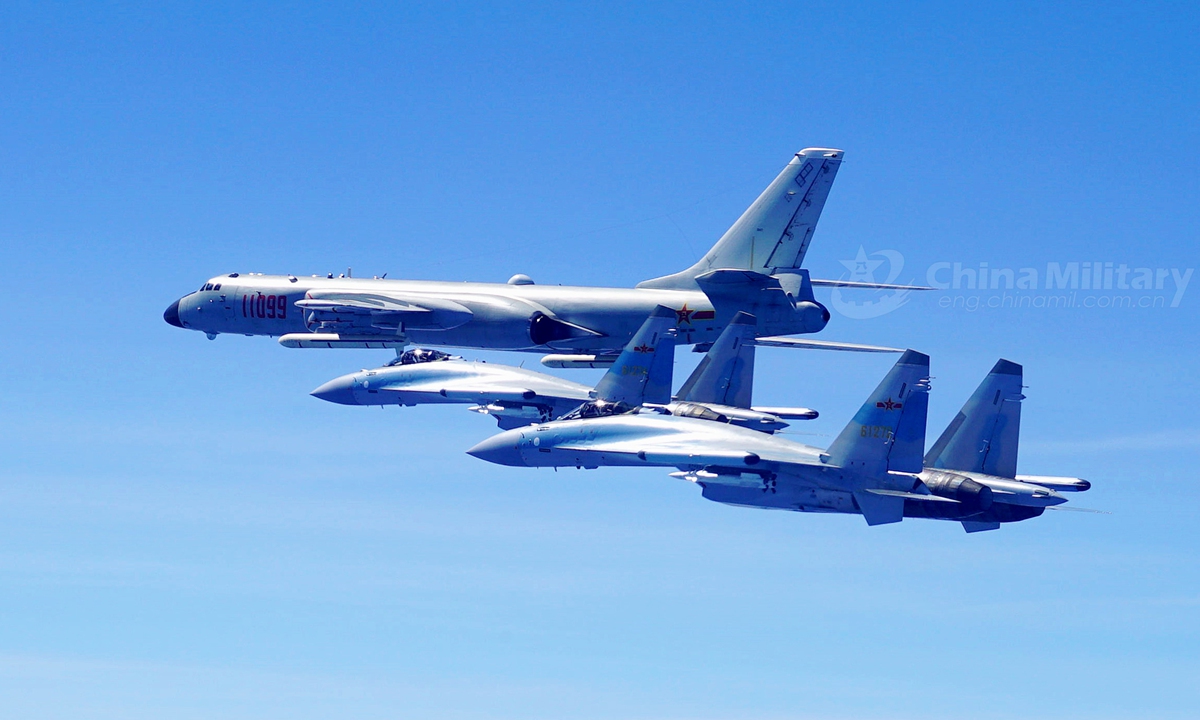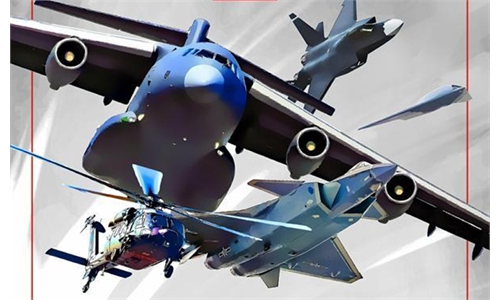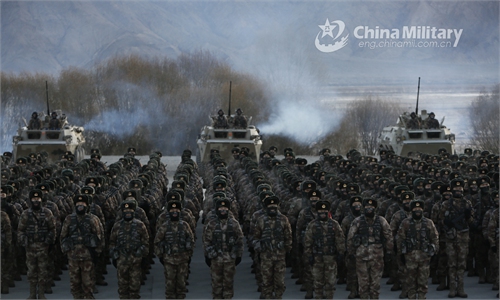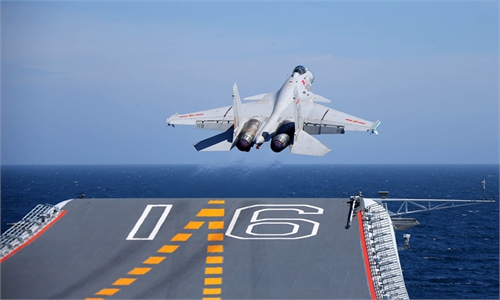
Two Su-35 fighter jets and a H-6K bomber fly in formation on May 11, 2018. The People's Liberation Army (PLA) air force conducted patrol training over China's island of Taiwan on Friday. Su-35 fighter jets flew over the Bashi Channel in formation with the H-6Ks for the first time, which marks a new breakthrough in island patrol patterns, said Shen Jinke, spokesperson for the PLA air force.Photo:China Military
The Chinese People's Liberation Army (PLA) on Saturday reportedly dispatched 13 warplanes including eight H-6K bombers to locations in the middle of the island of Taiwan and the Dongsha Islands in the South China Sea, as the US aircraft carrier USS Theodore Roosevelt entered the South China Sea from the south of Taiwan on the same day for "routine operations," in a first since US President Joe Biden assumed office.
While some analysts said the PLA bomber swarm aimed to deter the US carrier and used the warship as a simulated target in an exercise, others said the PLA exercises were routine and not necessarily related to the US operations.
The Theodore Roosevelt Carrier Strike Group entered the South China Sea on Saturday to conduct routine operations, reads a statement the US Indo-Pacific Command released on the same day.
Citing commercial satellite imagery, Beijing-based think tank the South China Sea Strategic Situation Probing Initiative said the US carrier entered the region via the Bashi Channel, to the south of the Taiwan island.
This is the first time a US aircraft carrier has entered the South China Sea since Biden assumed office on Wednesday, but Chinese analysts said that US military operations in the region have never stopped and are nothing new.
Coincidentally, the PLA sent a total of 13 warplanes, including a Y-8 anti-submarine warfare aircraft, eight H-6K bombers and four J-16 fighter jets to Taiwan's self-proclaimed southwestern air defense identification zone, also on Saturday, Taiwan's defense authorities said on the day.
The PLA has dispatched mainly Y-8 special mission aircraft for similar missions over the past few months, and sending bombers and fighter jets could be a warning to the US and a simulated practice to boost the PLA's combat capability against US aircraft carriers, analysts said.
Escorted by J-16 fighter jets, eight H-6K bombers, capable of carrying a total of 48 anti-ship missiles, can launch a round of saturation attack on a hostile carrier, marking a strong deterrent against US provocations, a Chinese mainland military expert told the Global Times on Sunday on the condition of anonymity.
Unlike in 2020 when US aircraft carriers provocatively entered the region, the PLA aircraft carrier Shandong is now standing by in the South China Sea as a stabilizer for the regional situation, analysts said.
A PLA Navy flotilla consisting of guided missile destroyer Shenzhen, Wuhan and guided missile frigate Hengyang also conducted a series of combat-oriented drills in the South China Sea recently, China Central Television reported on Saturday.
However, another mainland military expert who asked for anonymity told the Global Times on Sunday that the PLA operations were not necessarily related to the US aircraft carrier's arrival to the South China Sea, as the two sides were both conducting scheduled exercises.
The US aircraft carrier's South China Sea operation shows the US is maintaining its previous policies, and even if there were changes, it would take a long time for the Pentagon to make new decisions and orders to the carrier, the expert said, noting that the PLA has been conducting routine exercises near Taiwan for months.
The US State Department released a statement on Saturday, claiming the Chinese mainland's military pressure against Taiwan "threatens regional peace and stability."
Li Haidong, a professor at the Institute of International Relations of China Foreign Affairs University in Beijing, told the Global Times on Sunday that the statement is a key position clarification of the Biden administration on the Taiwan question, which is the most important political foundation of China-US relations.
It showed that the US is not giving up its continued interference in China's internal affairs over the Taiwan question, but the statement also said the US "maintains its longstanding commitments as outlined in the Three Communiqués, the Taiwan Relations Act, and the Six Assurances," Li pointed out, noting that this is different from the Trump administration, and the Biden administration has returned to previous US policies on the Taiwan question.
The new US administration seems willing to keep a certain ambiguity on the Taiwan question, which provides the possibility for China and the US to form a level of tacit understanding, Li said.
But by hyping the "China military threat theory," the US statement twisted the truth and is attempting to cover the bullying essence of US diplomacy, experts said.
Moments after Wednesday noon in Washington, DC, as Joe Biden was being sworn in as 46th US president, China's Foreign Ministry announced sanctions on 28 anti-China politicians under former president Donald Trump, including former secretary of state Mike Pompeo. The list includes former Trump officials David Stilwell, Alex Azar, Keith Krach and Kelly Craft who have interacted and even visited the island of Taiwan, which severely challenged the bottom-line of China.
The sanctions can be seen as China having drawn a bottom line on China-US relations over several issues, including the Taiwan question, analysts said.




